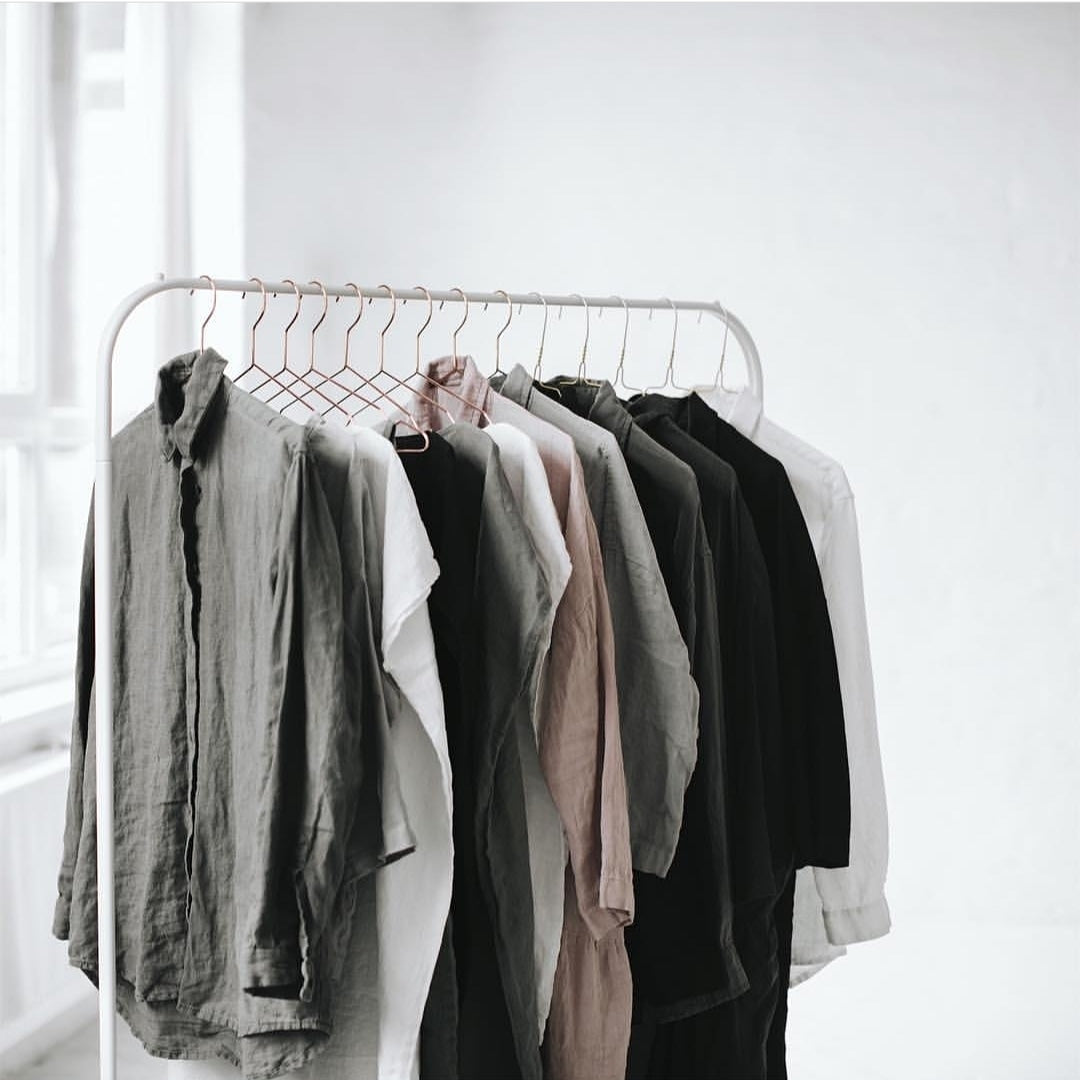Trying to figure out bed sheet sizes can feel a bit overwhelming, but it really just comes down to one thing: matching the sheet to your mattress. In New Zealand, standard sizes run from a compact Single (92 x 188 cm) all the way up to a spacious California King. Getting this one measurement right is the key to creating a comfortable, tidy bed.
NZ Bed Sheet Sizes at a Glance
Choosing the right sheets shouldn't be a guessing game. It all starts with knowing your bed's standard size. This quick guide is designed to cut through any confusion, giving you a clear, simple reference for all standard New Zealand bed dimensions. Think of it as your ultimate cheat sheet for bedding.
These numbers are more important than you might think. Getting them right saves you from the daily annoyance of a fitted sheet that constantly pops off a corner or a flat sheet that just won't stay tucked in. When you know your measurements, you can shop with confidence, certain that your new linens will be a perfect fit.
Your Quick Reference Chart
To make things even easier, we've put together a straightforward chart of standard mattress dimensions here in New Zealand. Use this to quickly find your bed size and its measurements, and you'll pick the right sheets every single time.
NZ Standard Bed Sheet Size and Mattress Dimensions Chart
This table lays out the most common mattress sizes found in New Zealand homes. Simply find your bed size to see the corresponding dimensions in both centimetres and inches.
| Bed Size | Dimensions (cm) | Dimensions (inches) |
|---|---|---|
| Single | 92 x 188 cm | 3'0" x 6'2" |
| King Single | 107 x 203 cm | 3'6" x 6'8" |
| Double | 137 x 188 cm | 4'6" x 6'2" |
| Queen | 153 x 203 cm | 5'0" x 6'8" |
| King | 167 x 203 cm | 5'5" x 6'8" |
| Super King | 183 x 203 cm | 6'0" x 6'8" |
| California King | 203 x 203 cm | 6'8" x 6'8" |
This chart is your first stop, but if you need an even more detailed breakdown, feel free to explore our complete bedding size chart, which covers everything from duvets to pillowcases.
Visualising Common Bed Sizes
Sometimes, seeing the difference is easier than reading about it. This visual guide compares the most popular bed sizes side-by-side.
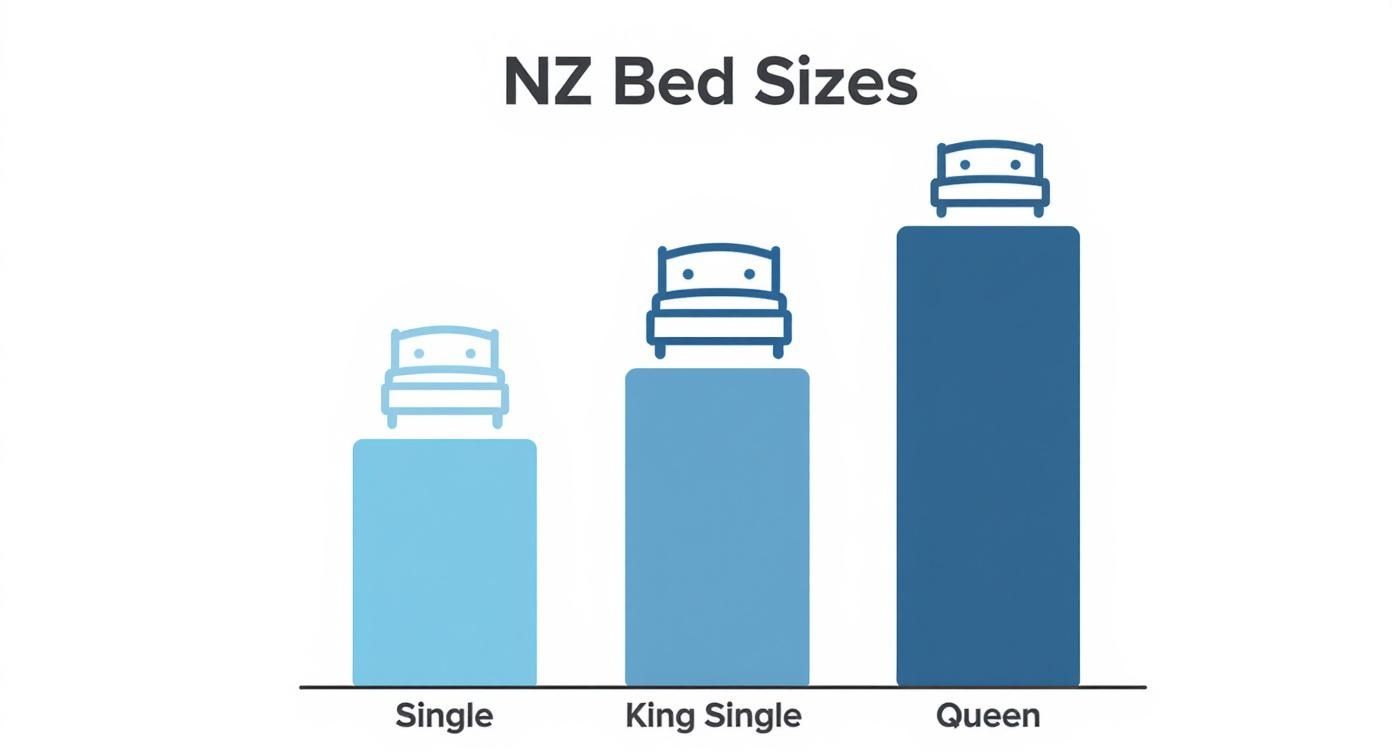
The infographic really shows the significant jump in width from a Single to a Queen, which is why having the correct size is so important for proper coverage. These standards make all the difference when you're shopping for new linens.
It’s also interesting to see how these standards play out in the wider market. The New Zealand market for cotton bed linen, for instance, has seen its share of ups and downs, recently valued at around $3.8 million. This figure hints at shifting consumer tastes and economic trends that shape what we all choose to buy.
Understanding the exact dimensions is the first step. It transforms bed linen shopping from guesswork into a simple, satisfying process of selecting beautiful, perfectly fitting sheets for your sanctuary.
How to Measure Your Mattress Like a Pro
We’ve all been there. You buy a new set of sheets, and the fitted sheet just won’t cooperate. It either swims on the mattress or, worse, pings off a corner in the middle of the night. The secret to getting that crisp, hotel-perfect fit isn't just about choosing a "Queen" or "King" size; it's about knowing your mattress's exact dimensions.
Let's walk through how to measure your mattress properly, focusing on the three numbers that really matter: length, width, and the all-important depth.
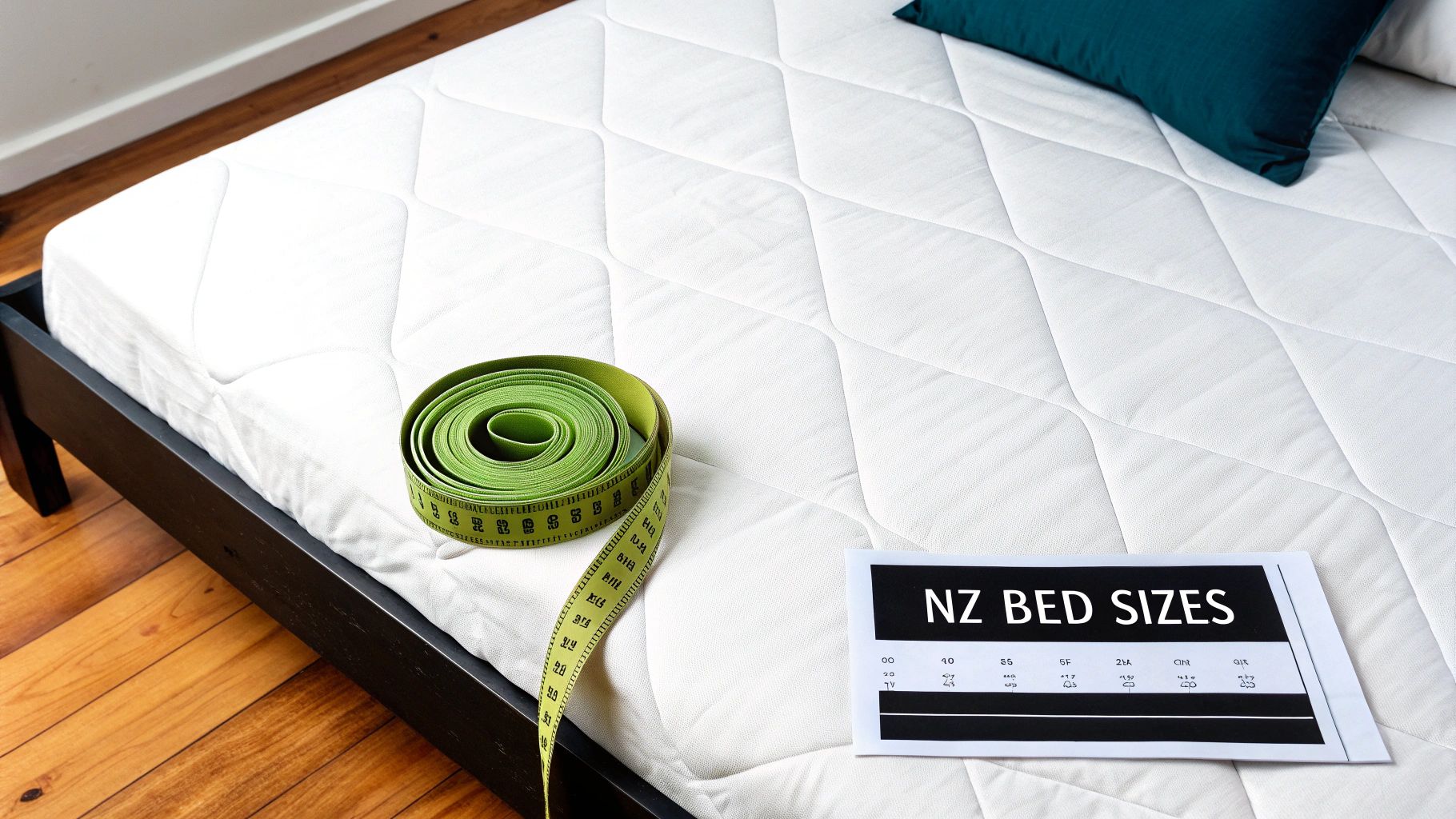
Think of a fitted sheet like a custom-tailored suit for your bed. If your mattress has a plush pillow-top or you’ve added a comfy topper, that standard "off-the-rack" sheet just won't do. You need one with enough room to accommodate the extra height. Nailing these simple measurements is the key to finding sheets that hug your mattress just right.
Your Three Essential Measurements
First things first, grab a retractable measuring tape. It’s far more reliable than a floppy ruler for this job. For the most accurate results, strip the bed completely—yes, even the mattress protector. You want to measure the mattress itself.
You're looking for three key numbers:
- Length: How long your mattress is, from head to foot.
- Width: How wide it is, from side to side.
- Depth (or Height): How thick it is, from top to bottom.
With these three figures noted down, you can shop for sheets with total confidence, knowing you'll get a perfect fit every time.
Step 1: Measure the Length and Width
Let's start with the basics. To get the length, place the end of your measuring tape at the centre of the head of the mattress and pull it straight down to the centre of the foot. Write that number down. Make sure you're not measuring along a curved edge; a straight line is what we're after.
Next up, the width. Stretch the tape across the widest part of the mattress, from the left edge straight across to the right. This measurement, along with the length, confirms whether you have a standard Queen, King, or another size.
Pro Tip: If you land between centimetres, always round up to the next whole number. That tiny bit of extra room can be a lifesaver, especially after the sheets have been through their first wash.
Step 2: Measure the Crucial Mattress Depth
Okay, this is the step most people miss, and it’s the number one reason fitted sheets don’t fit. A modern mattress with a lofty pillow-top or an added memory foam topper can easily be 5-10 cm deeper than a standard one. That difference is huge when it comes to sheets.
Here's the easiest way to get a truly accurate depth measurement:
- Lay a hardcover book or another flat, firm object on the top of the mattress so it hangs just over the side. This gives you a perfectly level top edge to measure from.
- Now, measure from the bottom edge of the mattress straight up to the bottom of the book.
- That number is your mattress depth. Remember to include any integrated pillow-tops in this measurement.
If you use a separate mattress topper, it’s a good idea to measure the depth twice—once with the topper on, and once with it off. This gives you the flexibility to buy sheets that can handle either scenario. With these three precise measurements in hand, you're now ready to find sheets that feel like they were made just for your bed.
Decoding the Language of Bed Sheets
Shopping for high-quality linens can feel a bit like learning a new language. You'll see terms like 'pocket depth' and 'flat sheet drape' tossed around, but what do they actually mean when it comes to making your bed? Getting a handle on this terminology is the first step to choosing sheets that not only fit but perform beautifully.
Let's break it down. A standard sheet set is more than just a few pieces of fabric; it’s a system where each part has a specific job. Understanding what each piece does makes it clear why their dimensions are so critical for achieving that perfect, hotel-style finish.
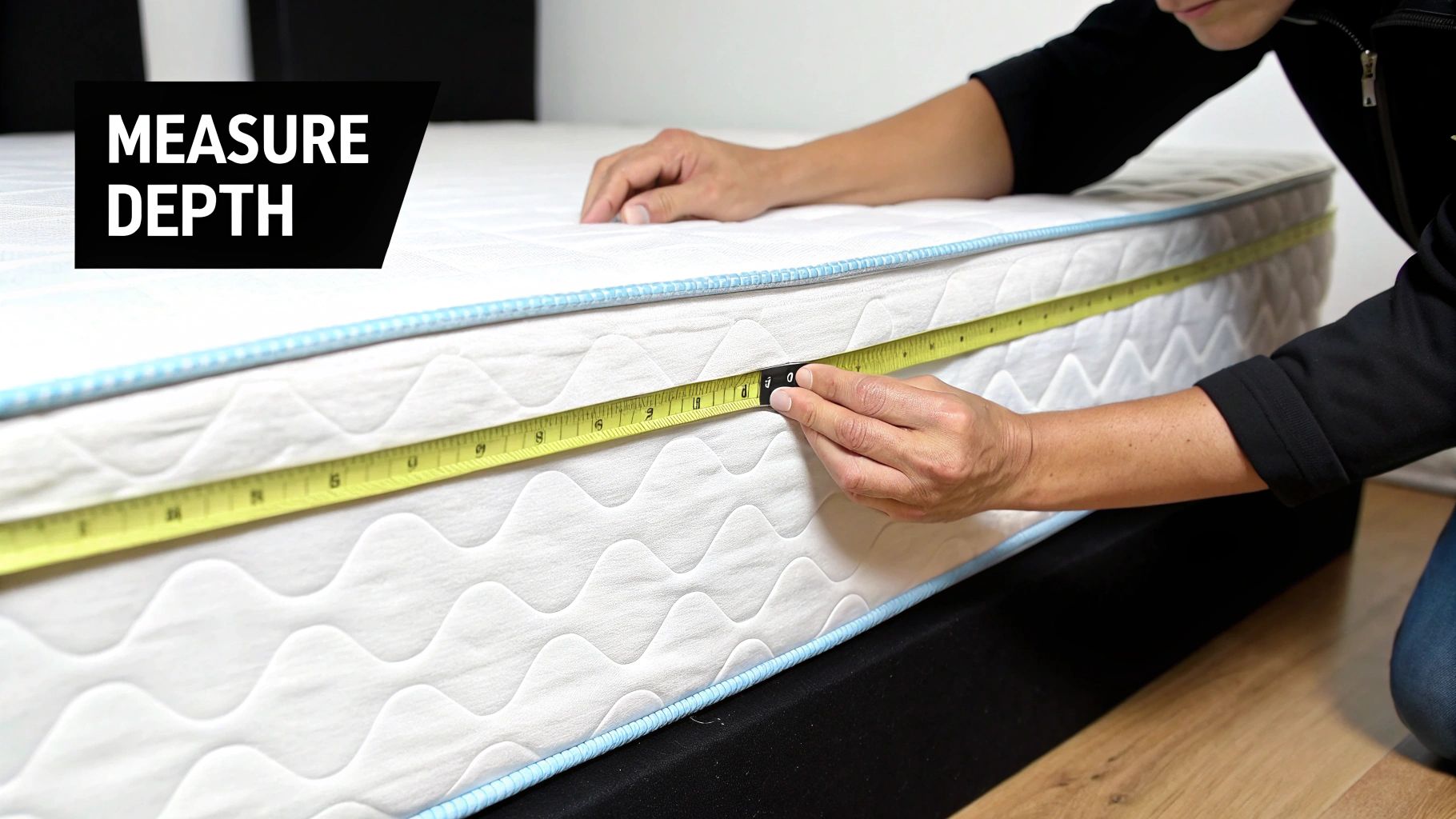
The Three Pillars of a Sheet Set
At its heart, a sheet set is a team of three distinct pieces, each designed to contribute to the comfort and look of your bed. Think of them as the foundation, the comfort layer, and the finishing touch.
Here’s a quick look at the main players:
- The Fitted Sheet: This is the workhorse. Its elasticated corners are designed to grip your mattress, creating a smooth, unwrinkled base.
- The Flat Sheet: Often called a top sheet, this is the layer that lies between you and your duvet or blanket, adding a touch of soft, breathable comfort.
- Pillowcases: These are the simple, elegant covers that protect your pillows and tie the whole look together.
While they all work in harmony, the fitted and flat sheets have some dimensional quirks you'll want to get right for a flawless fit.
Understanding Fitted Sheet Pocket Depth
After length and width, the single most important measurement for your fitted sheet is its pocket depth. It’s a simple concept: this number tells you how thick of a mattress the sheet can handle.
Think of it like trying to put a small hat on a very big head—it’s just not going to sit right. The same is true for your sheets. Your fitted sheet’s pocket must be deeper than your mattress is thick, or it will never wrap securely underneath.
Crucial Takeaway: A good rule of thumb is to find a pocket depth at least 5 cm deeper than your mattress. This extra fabric is what allows the elastic to tuck firmly under the mattress, preventing those annoying corners from popping off in the middle of the night.
So, if you have a 30 cm mattress, you should be looking for a fitted sheet with a pocket depth of at least 35 cm. This little bit of extra room makes all the difference, ensuring a snug fit that stays put, no matter how much you toss and turn.
The Art of the Flat Sheet Overhang
The fitted sheet is all about precision, but the flat sheet is a different story. It’s all about generous proportions. You'll notice its dimensions are significantly larger than the mattress itself, and for good reason: the overhang.
The overhang is simply the extra fabric that drapes over the sides and foot of your bed. This isn't wasted material; it's essential for both function and aesthetics. It’s what gives you enough fabric to tuck in for those crisp, clean lines you see in a beautifully made bed.
Sufficient overhang delivers on a few key promises:
- A Secure Tuck: You'll have plenty of length to tuck the sheet deep under the foot of the mattress, so it won’t come loose.
- Ample Coverage: The sheet is wide enough to keep you comfortably covered, even if your partner tends to hog the blankets.
- A Polished Look: A generous drape just looks more luxurious and inviting than a sheet that barely skims the surface.
When you look at bed sheet sizes, you’ll see this in action. A Queen flat sheet might measure 245 x 275 cm to properly dress a 153 x 203 cm mattress. This intentional, generous sizing is a hallmark of quality bedding, designed for superior comfort and a pristine finish.
Avoiding Common Sheet Sizing Pitfalls
Even when you think you have all the right measurements, buying new sheets can still feel like navigating a minefield. Choosing the wrong bed sheet sizes is a surprisingly common and frustrating mistake, but with a bit of know-how, you can easily sidestep the usual sizing headaches. Think of this as your guide to troubleshooting those small but crucial details that make a world of difference.
We'll tackle everything from confusing international labels to how fabrics behave over time. This extra knowledge will help you invest in linens that not only fit perfectly on day one but for years to come. Let's get these common issues sorted so you can shop with total confidence.
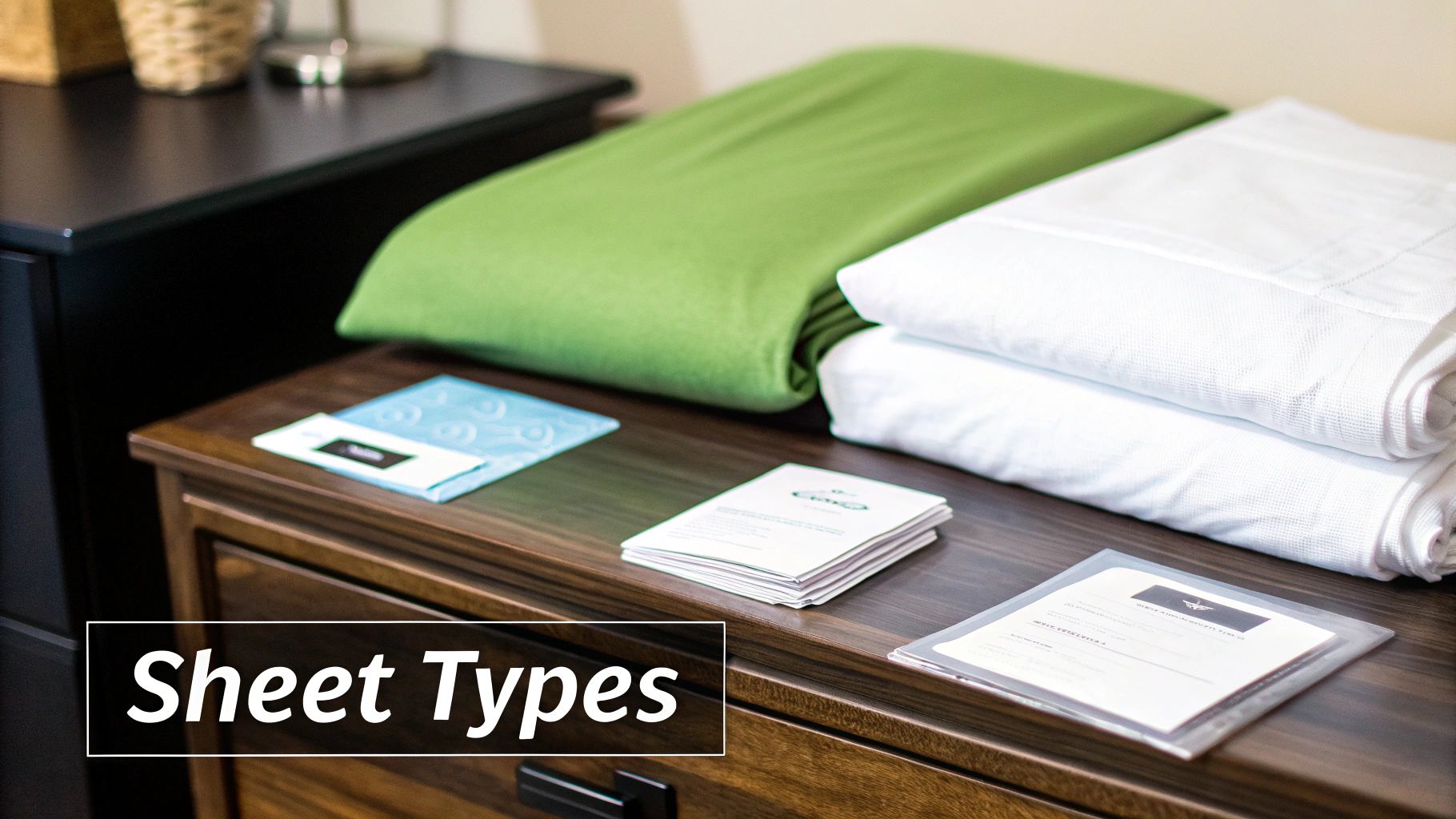
King vs. California King: The Critical Difference
On the surface, a King and a California King sound almost identical. But in reality, their dimensions are completely different, and their sheets are absolutely not interchangeable. Trying to swap them is a guaranteed recipe for a rumpled, ill-fitting bed and a frustrating night's sleep.
Here’s the simple way to remember it:
- A Standard King is the wider, slightly shorter one.
- A California King is narrower but longer, perfect for taller people.
Picture trying to stretch a King fitted sheet over the longer California King mattress—you'd never get the corners to stay on. On the flip side, a Cal King sheet would be far too narrow for a Standard King. Always, always double-check the exact name of your bed before you add anything to your cart.
Decoding International Bed Sheet Sizes
Falling in love with linens from an overseas brand can open up a world of beautiful new options, but it also means dealing with different sizing standards. A "King" bed in New Zealand is not the same size as a King in the US or the UK, and relying on the name alone is a trap.
When you're buying from an international retailer, completely ignore the size name (like Queen or King). The only thing that matters is the dimensions listed in centimetres. That's your single source of truth for ensuring a perfect match with your NZ bed.
Making this a habit will save you from the hassle of costly returns and the disappointment of receiving sheets that are unusable. It’s a simple check that guarantees your new bedding will feel right at home, no matter where in the world it came from.
The Truth About Fabric Shrinkage
Ever pulled a new set of beautiful cotton sheets from the packet and thought they felt a little… generous? That’s not a mistake; it's by design. Natural fibres, especially high-quality cotton and linen, are meant to shrink a bit during their first few washes, usually by around 2-5%.
Good brands know this and plan for it. They deliberately cut their sheets slightly larger, a thoughtful process known as preshrinking. This bit of foresight ensures that after a couple of trips through the washing machine, your sheets will relax into their true, perfect size. It's a hallmark of quality craftsmanship, designed for a lasting, impeccable fit.
This kind of attention to detail is essential in the New Zealand bedding market, which is part of a home furnishings sector with revenues around NZD 122.72 million. With the Manchester Retailing industry showing consistent growth, it’s clear that Kiwis value well-made products built to last.
Ultimately, avoiding these common problems just comes down to paying attention to the details. By understanding the key differences between similar-sounding sizes, prioritising centimetre measurements for international buys, and appreciating how natural fabrics settle over time, you can shop smarter and make a choice you'll be happy with for years.
Matching Your Sheets to Your Mattress Type
Getting the right bed sheet dimensions is a great start, but creating a truly amazing sleep setup is about matching your sheets to your mattress technology. A quality mattress deserves equally good sheets that work with it, not against it. Some mattress types have unique quirks that go way beyond simple length and width.
Think of it like this: you wouldn't wear hiking boots with a silk gown. In the same way, the wrong sheets can completely cancel out the very features you bought your mattress for. Let's move past just the measurements and look at how to pair the right sheets with different mattress technologies for the perfect partnership.
For Adjustable and Articulating Beds
Adjustable beds, which can raise your head and feet, put an incredible amount of strain on a fitted sheet. As the mattress bends and flexes, a standard sheet can easily be wrestled free from the corners. This is where the actual construction of your fitted sheet really matters.
For these dynamic sleep systems, you need a sheet with two non-negotiable features:
- Robust, All-Around Elastic: Look for a fitted sheet with a strong, continuous elastic band sewn all the way around the hem—not just bunched up at the corners. This creates a powerful, consistent grip that holds the sheet firmly in place, no matter what position your bed is in.
- Deep Pockets: A generous pocket depth is even more critical here. It provides the extra fabric needed to accommodate the mattress's movement without putting stress on the seams or causing the corners to pop off.
For Memory Foam and Heat-Retaining Mattresses
Memory foam mattresses are famous for their body-hugging comfort, but some have a reputation for trapping body heat, which can lead to a warmer night's sleep. If you find yourself sleeping hot, your sheets can either make the problem worse or become part of the solution.
Breathable, natural fibres are your best friend here. Materials like pure linen or crisp cotton percale allow air to circulate freely, wicking moisture away from your body and helping to dissipate that trapped heat. These fabrics work with your mattress to create a much cooler, more comfortable sleep environment.
A common mistake is to pair a high-tech cooling mattress with heavy, synthetic sheets. This completely negates the mattress's cooling properties. Your bedding should always complement your mattress's features, not fight them.
For those with larger beds who are after this specific kind of comfort, understanding how to dress them properly is key. For example, learning the finer points of Super King sheets in NZ can ensure you get both the right size and the ideal fabric for your setup.
The Impact of Mattress Toppers
Mattress toppers are a fantastic way to add an extra layer of plush comfort, but they can dramatically change your bed’s profile. A thick foam or featherbed topper can add anywhere from 5 to 15 cm to your mattress height, turning your standard bed into a deep-profile one overnight.
It is absolutely crucial to include this extra layer when you measure your mattress depth. Keep the topper on the bed and measure the total height from the bottom edge of the mattress to the very top of the topper. This new, combined depth is the number you need to use when shopping for fitted sheets. Forgetting to account for it is the number one reason sheets don't fit.
This principle applies to all sorts of sleep surfaces, not just traditional beds. For more specialised setups, knowing the dimensions of something like a tri-fold pack n play mattress is essential for finding sheets that fit perfectly, as even portable options require precise sizing for safety and comfort.
Why Fabric and Weave Matter as Much as Fit
So, you've mastered the measurements and you know your mattress inside and out. But getting that perfect, restorative sleep goes one step deeper. The right fit is the foundation, absolutely, but the right fabric is what truly transforms your bed from just a piece of furniture into a personal sanctuary.
Think of it this way: a bespoke suit tailored to your exact measurements would be a disappointment if it was made from scratchy, cheap polyester. The same logic applies here. Sheets with the correct bed sheet sizes but a poor-quality fabric can completely undermine the luxurious comfort you're after.
The Art of Comfort and Feel
The texture of your sheets—how they actually feel against your skin—directly influences your sleep experience. Different weaves create entirely different sensations, and figuring out what you like is the key to finding your perfect match.
-
Crisp Percale: This is a classic plain weave with a matte finish that feels cool and crisp, almost like a freshly ironed dress shirt. It’s incredibly breathable, which makes it a fantastic choice for anyone who tends to sleep a bit warm.
-
Silky Sateen: Using a satin weave structure gives these sheets a beautiful lustre and a silky-smooth hand-feel. Sateen drapes elegantly and feels a little heavier and warmer than percale, wrapping you in a more opulent, cosy sensation.
Ultimately, choosing between them really comes down to personal preference. Do you love the light, cool embrace of percale, or do you prefer the rich, silky touch of sateen? The answer to that question defines the final, crucial layer of your sleep comfort.
A well-fitting sheet makes the bed look neat and tidy, but the right fabric makes it feel incredible. Investing in quality material is an investment in the quality of your rest, night after night.
This growing appreciation for quality materials isn't just a hunch; it's a trend we're seeing here in New Zealand and around the world. The global home bedding market was recently valued at over USD 104 billion and is expected to climb to nearly USD 173 billion within the next ten years. This points to a massive shift towards people investing in premium comforts for their homes, a trend you can explore in this global market analysis.
Of course, the quality of the fabric also determines how long your sheets will last and how well they'll hold their shape wash after wash. If you’re keen to learn more, our guide on the best thread count for sheets dives deeper into durability. By pairing precise measurements with superior fabrics, you create a sleep experience that is not only perfectly fitted but also deeply comforting and luxurious.
Got Questions About Bed Sheet Sizes? We've Got Answers
Even with a tape measure in hand, a few questions always seem to come up when you're on the hunt for new sheets. Let's tackle some of the most common ones I hear, so you can navigate those tricky real-world scenarios and buy your next set with total confidence.
Think of this as the final piece of the puzzle, covering those little details that make all the difference between a good night's sleep and a frustrating one.
Can I Get Away With Using King Sheets on a Super King Bed?
In a word? No. While it might seem like a small difference on paper, trying to force a King fitted sheet onto a Super King mattress is an exercise in futility. There’s simply not enough fabric to stretch across the extra width, which means one thing: the corners will pop off the second you get into bed.
The flat sheet won't fare much better. It'll be too narrow, leaving you with barely any fabric to tuck in. This leads to a messy bed and a night spent fighting for cover. For a truly comfortable and well-made bed, you really do need to buy the size that matches your mattress.
What if My Mattress Is a Custom Size?
If you've invested in a unique, custom-sized bed, off-the-shelf sheets just aren't going to cut it. The best path forward is to find a company that specialises in made-to-measure linens.
You'll need to give them the exact measurements—length, width, and depth. Yes, it’s a more premium route, but it’s the only way to get that flawless, secure fit your non-standard bed deserves.
A well-fitting sheet isn't just about looks; it's about creating a smooth, comfortable surface for sleep. For custom beds, tailored sheets are less of a luxury and more of a necessity.
Do Australian Bed Sheet Sizes Fit NZ Beds?
Sometimes, but it pays to be cautious. While common sizes like Single and Queen are often the same in both New Zealand and Australia, things can get a bit tricky with the larger sizes. You'll find slight but crucial differences, especially between King and Super King beds.
An Australian King, for example, is often a different width to an NZ King. The golden rule here is to completely ignore the name on the label—King, Super King, whatever it says—and focus only on the dimensions in centimetres. That's the only way to compare apples with apples and know you're getting a perfect match.
How Much Do Cotton Sheets Actually Shrink?
It’s completely normal for sheets made from 100% natural fibres like cotton or linen to shrink a little, usually around 2-5%, after the first few washes. We know this, and any good bedding maker does too, which is why we design our sheets to be slightly oversized right out of the packet.
That little bit of extra fabric is there by design. It ensures that once the fibres have settled after washing, your sheets will fit your mattress like a glove. To keep shrinkage in check, just follow the care instructions—especially on water temperature and drying—and you'll be set.
At The Foxes Den, we believe a perfectly fitting sheet is the true foundation of a beautiful bed. Our collections of premium linen and Supima® cotton bedding are crafted with an obsessive focus on sizing and quality, bringing pure comfort into your home. Find your perfect fit by exploring the collection today at https://www.thefoxesden.co.nz.
